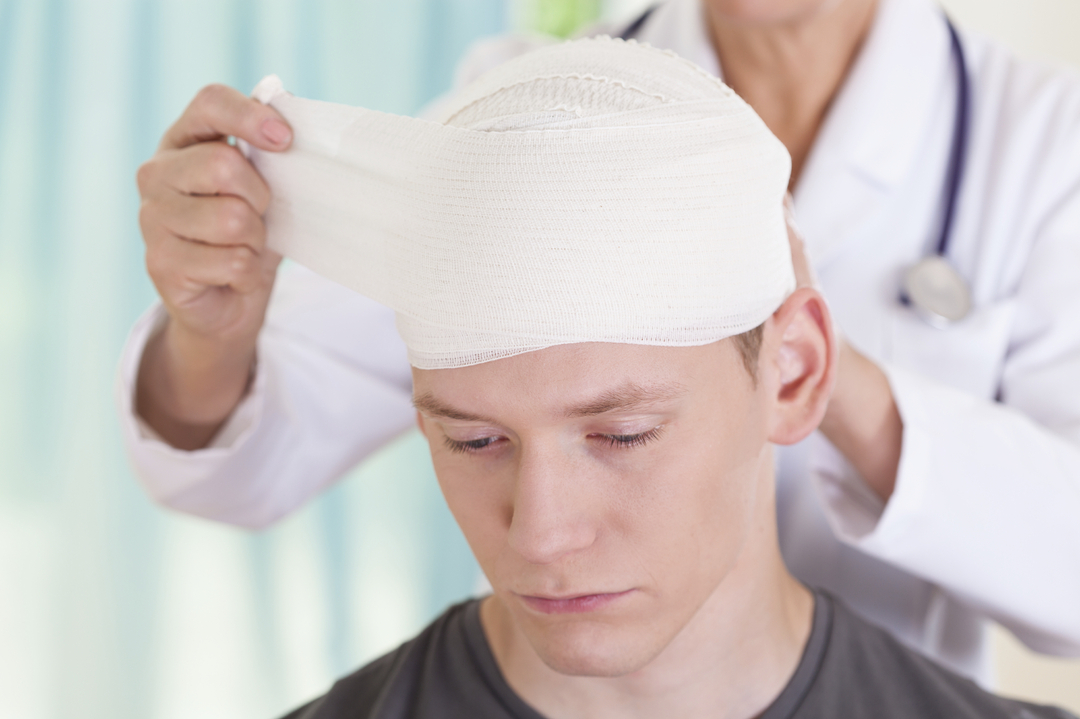Human stem cells: application in modern medicine
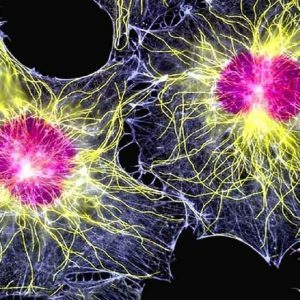
The technique of stem cell transplantation has been widely used today to treat serious pathologies.In particular, immature hematopoietic cells are used to restore hematopoietic function in patients with leukemia and lymphomas.The first successful transplantation was carried out in 1988.An anemia patient was given cells taken from umbilical cord blood, and this allowed for complete healing.
Table of contents: Concept and features of stem cells Types of stem cellsConcept and features of stem cells
Stem cells are immature cells that have the capacity for self-renewal, as well as differentiation.The essence of self-renewal lies in the fact that after mitotic division these cells retain their phenotype, that is, no differentiation occurs.Differentiation is the transformation into specific cells of various tissues and organs.
Stem cells are characterized by an amazing ability to asymmetric division, after which one of the new cells remains trunk, and the other becomes differentiated.
Note: development of the body begins with a single stem cell - the zygote.In the course of multiple division and differentiation, all other cell types that are characteristic of a particular biological species are formed.In particular, in humans and primates, there are more than 220 cell types.
Stem cells are a universal "building material" for body tissues.They contain all the genetic information.Due to immature cellular elements, regeneration processes are carried out in the body.With aging, the number of undifferentiated cells is steadily decreasing.If the fetus( embryo) has 1 stem cell for every 10 thousand differentiated, then by the age of 60 the ratio varies many times, falling to 1 to 8 million.It is for this reason that damaged tissues regenerate much more slowly in elderly patients.
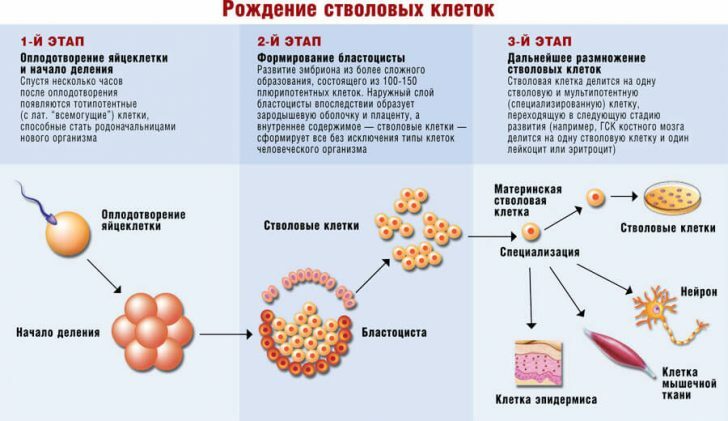
Please note: has created special banks in order to preserve such unique biological material as blood from the umbilical cord.The results of many years of research suggest that soon universal unripe cells will help cope with severe pathologies, which are now not treated either medically or surgically.
Stem cell types
Important: The best source for obtaining stem cells is blood obtained from the umbilical cord immediately after the baby's birth.These cells are also present in the placenta and embryonic tissues.In an adult, such cellular elements are in the bone marrow.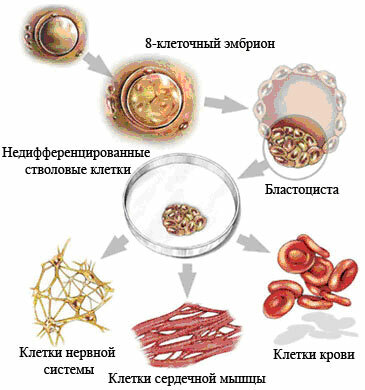
To date, researchers have been able to identify the following types of stem cells:
- hemopoietic;
- endothelial;
- nerve;
- myocardial stem cells;
- dermal;
- mesenchymal;
- is muscular;
- intestinal cells;
- fetal.
Cord blood cells
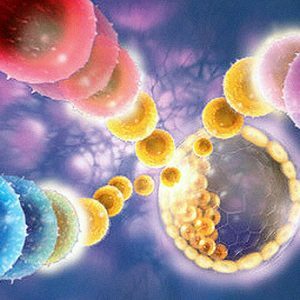 A very large number of immature cells can be obtained from blood taken from the umbilical vein.The unique biomaterial is stored in a special jar at a temperature of -196 ° C( in liquid nitrogen).It can be used when it is necessary to restore almost all the widows of tissues of the human body.Banks conclude with the relatives of the child born the contract for the storage of biodeposit for 18-20 years.All this time the material remains fully active.
A very large number of immature cells can be obtained from blood taken from the umbilical vein.The unique biomaterial is stored in a special jar at a temperature of -196 ° C( in liquid nitrogen).It can be used when it is necessary to restore almost all the widows of tissues of the human body.Banks conclude with the relatives of the child born the contract for the storage of biodeposit for 18-20 years.All this time the material remains fully active.
Note: in the placenta of undifferentiated cells is an order of magnitude larger than in cord blood.However, for the storage of biological material of this kind, special conditions are required, which is associated with enormous material costs.
Hemopoietic cells from cord blood have the following advantages:
- material is easy and completely painless;
- biomaterial is infectious;
- transplantation is possible at any time;
- cells are suitable for transplantation to close relatives( ideal biocompatibility);
- can be transplanted to other patients( provided there is no conflict over the antigens).
Important: The use of this biological material, as well as its disposal, does not lead to ethical or legal problems.
Hematopoietic cellular elements
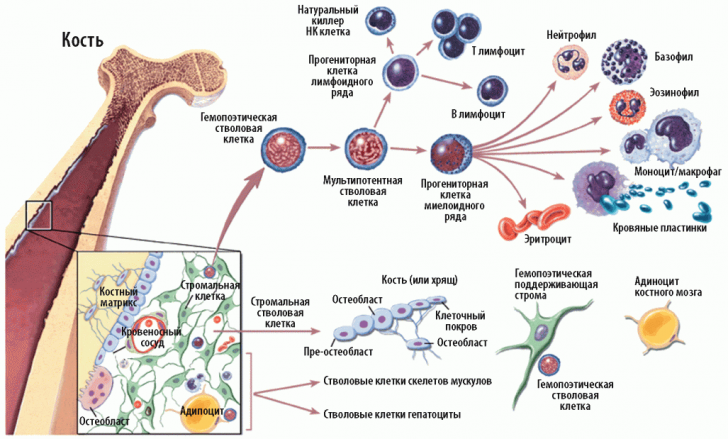
The source of stem cells in an adult is the red bone marrow.Stromal elements are obtained by puncture.In a special laboratory, whole colonies are grown from them, which are then transplanted to the patient.Once in the body, they migrate to the affected area, where the deceased are replaced by highly differentiated elements.
Important: adult stem cells have relatively low functional activity when compared to embryonic material.In addition, stromal cells can be transplanted only to the person from whose bone marrow they are obtained;Otherwise, the reaction of rejection practically inevitably develops.
Nervous stem cells
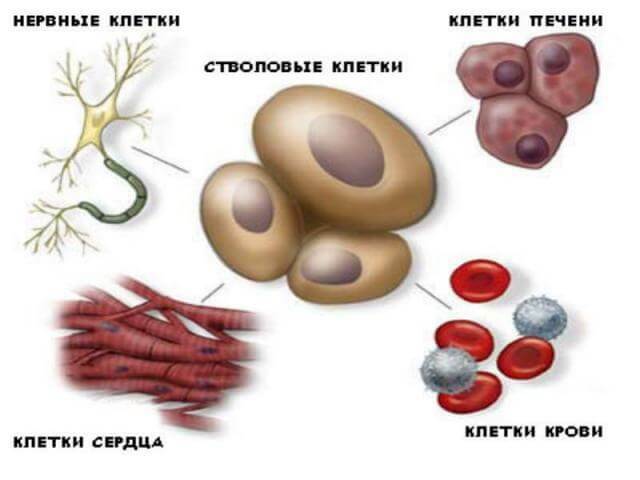
NSCs are found in isolated areas of the brain of a maturing or already definitively formed organism.They are characterized by a high ability to transform into other cells and can be cultivated in the laboratory.However, they are not used for treatment at this time.To obtain them, brain destruction is necessary, so there is no question of autotransplantation.Currently, the possibility of using recipient tissues is being studied, but this may be due to ethical problems.
Cells of the myocardium
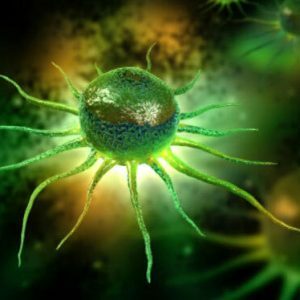 Unique stem cells that have the ability to transform into cardiomyocytes were discovered at the end of the last century.Human treatment with their help is not yet possible, because the material requires destruction of the myocardium, and the possibility of using the cells of the recipient is only being studied.
Unique stem cells that have the ability to transform into cardiomyocytes were discovered at the end of the last century.Human treatment with their help is not yet possible, because the material requires destruction of the myocardium, and the possibility of using the cells of the recipient is only being studied.
Skin cells
This type of stem cells is obtained from the skin of an embryo or an adult.Such biological material has already been successfully used in specialized centers for the treatment of patients with extensive burn lesions.
Mesenchymal cell elements
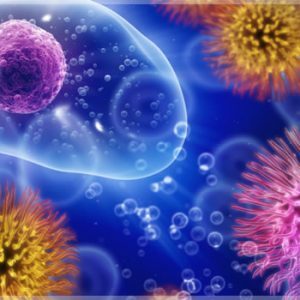 Mesenchymal stem cells are taken from the marrow stroma.They are also found in the blood obtained from the umbilical cord.Treatment by means of MSC transplantation is considered very promising.The material can be obtained from the patient himself;Cultivation is carried out in laboratory conditions on nutrient media.After transplantation, these cells become elements of various tissues and organs.If necessary, the material is frozen and stored for a long time.The undoubted advantage of treatment with mesenchymal cells is the absence of complications in the form of development of malignant neoplasms.The only disadvantage of this method is the need for strict infection control.
Mesenchymal stem cells are taken from the marrow stroma.They are also found in the blood obtained from the umbilical cord.Treatment by means of MSC transplantation is considered very promising.The material can be obtained from the patient himself;Cultivation is carried out in laboratory conditions on nutrient media.After transplantation, these cells become elements of various tissues and organs.If necessary, the material is frozen and stored for a long time.The undoubted advantage of treatment with mesenchymal cells is the absence of complications in the form of development of malignant neoplasms.The only disadvantage of this method is the need for strict infection control.
Undifferentiated cells of skeletal musculature
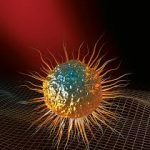 The source of the material is the tissue of the striated musculature.These elements have the ability to transform into nerve and fat cells, as well as into chondrocytes and myocytes.It is established that they represent a separate population of mesenchymal cells, hence can be obtained from umbilical cord blood or the patient's own bone marrow.
The source of the material is the tissue of the striated musculature.These elements have the ability to transform into nerve and fat cells, as well as into chondrocytes and myocytes.It is established that they represent a separate population of mesenchymal cells, hence can be obtained from umbilical cord blood or the patient's own bone marrow.
Embryonic stem cells
Cells from abortive material
So-called fetal cells are secreted from abortive material with artificial termination of pregnancy for a period of 9 to 12 weeks.The use of this source is associated with a variety of technical problems, not to mention the ethical side of the issue.
The main disadvantages of the treatment of embryonic stem cells:
- high risk of rejection when transplanting material;
- presence of the risk of HIV infection and infection with other diseases of infectious genesis;
- legal problems.
Embryonic stem cells
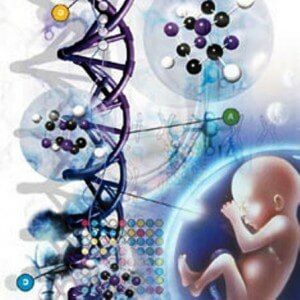 The ESB source is the embryo material taken at the first week of intrauterine development.
The ESB source is the embryo material taken at the first week of intrauterine development.
Advantages of embryonic stem cells:
- ability to transform into a wide variety of cells;
- minimal probability of rejection of crops.
Among the shortcomings are:
- the presence of the risk of the appearance of benign neoplasms;
- ethical issues;
- legal obstacles.
Important: in the Russian Federation, the use of ESC is now prohibited by the order of the Ministry of Health of the Russian Federation.The use of this biological material is regarded by opponents of the technique as an encroachment on the life of an unborn child.
Application of stem cells in medicine
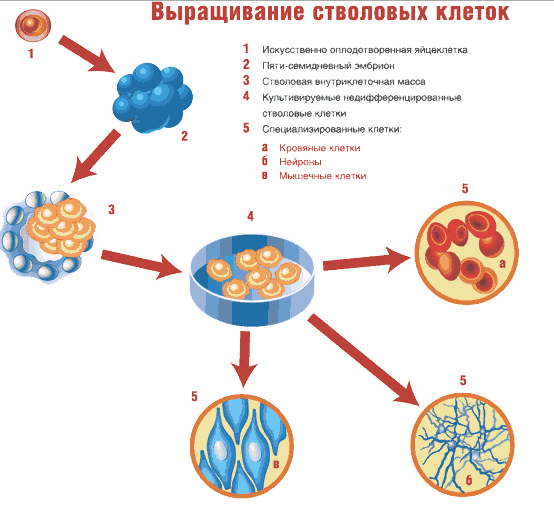
To date, tens of thousands of successful transplants to patients of different ages have already been carried out in different countries.
Stem cell culture transplantation has been recognized as a very effective technique for treating the consequences of spinal and spinal cord injuries, extensive burns, strokes and heart attacks.Cellular therapy makes it possible to cure a child suffering from serious blood pathology.
Note: is now 75% of patients who are in urgent need of organ transplantation, die without waiting for their turn to transplant.Scientists believe that cell therapy in the near future will give them a chance to be cured.
Stem cell transplantation is effective in the treatment of the following pathologies:
- immunodeficiency states;
- systemic lupus erythematosus;
- resistant juvenile arthritis;
- leukemia;
- non-Hodgkin's lymphoma;
- Fanconi anemia;
- thalassemia;
- idiopathic aplastic anemia;
- amygakaryocytic thrombocytopenia;
- collagenoses;
- myelodysplastic syndrome;
- malignant breast tumors;
- neuroblastoma.
Stem cells in cosmetology
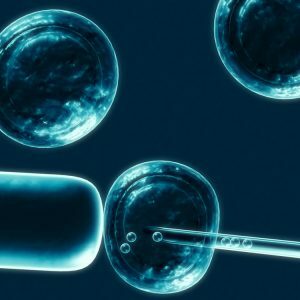 Introduction of stem cells helps to restore and improve the skin condition.
Introduction of stem cells helps to restore and improve the skin condition.
Important: for patients who want to undergo a course of rejuvenating procedures with the use of stem cells, it is recommended to use only the services of well-established cosmetology centers.The market has a huge number of counterfeit drugs that can cause irreparable harm to health.There are already known cases of death of patients due to the development after cancer procedures.
Cosmetic problems that can be eliminated by cell therapy:
- alopecia( alopecia);
- scars on the skin;
- wrinkles;
- pigmentation;
- traces of chemical burns;
- spots left after acne;
- consequences of laser therapy.
Note: mesotherapy with the introduction of preparations containing stem cell cultures makes it possible to significantly improve the tone of the skin and promote the growth of healthy hair and nails.
The treatment course requires the introduction of 100 million undifferentiated cells.The cost of course therapy is about 300 thousand rubles, which is due to technical difficulties in the cultivation of material for transplantation.
The session of mesotherapy in the cosmetology center is much cheaper( on average - about 20 thousand rubles), but to achieve a noticeable and lasting effect requires 5 to 10 procedures, so their total cost is quite comparable to the cost of treating a serious disease.
So, stem cells are not yet a panacea, but, undoubtedly, that improvement of techniques in the foreseeable future will help many hopelessly sick patients.
Vladimir Plisov, medical reviewer


